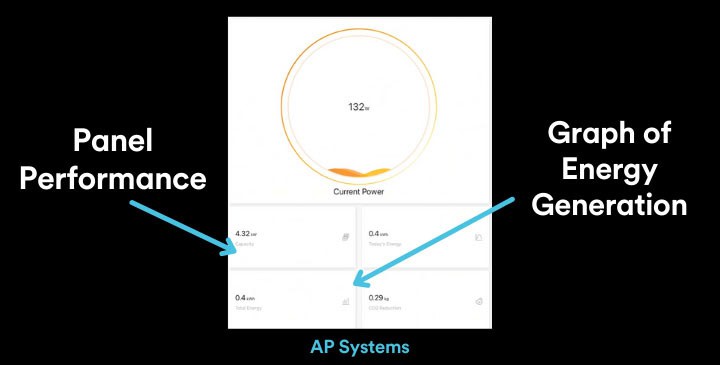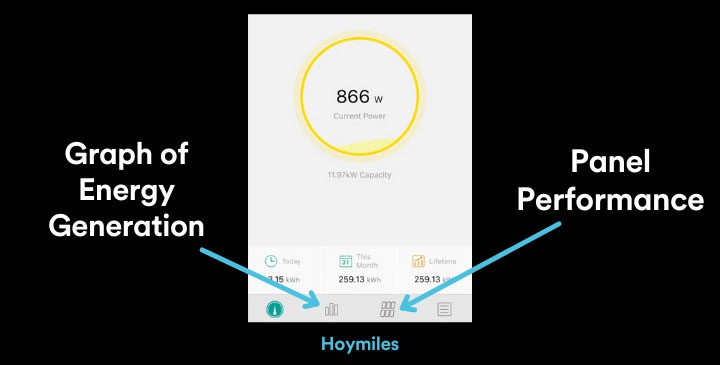With over 200 days of sunshine in Montana, you’ve made the smart decision to stop renting your power and own it with rooftop solar!
For homeowners, solar is often the biggest investment made apart from buying your home. Understanding how your solar monitoring system works helps you to make sure you get all the benefits from that investment.
When you make the switch to solar with a professional solar installer like Purelight Power in Montana, your solar monitoring that’s connected to your panels is an app that you can access right on your phone or tablet. You can see what’s going on with your solar panels at any time.
Thankfully, most of the time solar is pretty low maintenance. Unlike wind or hydro, there aren’t moving parts that are more likely to break. But like any technology, it’s good to understand what your system is doing.
So how does your solar monitoring app work?
Monitoring Solar in Montana Right From Your Phone
While few of us are ever excited to read a “how to” manual, in this case it’s worth it. In the next few short paragraphs, we’ll show you how to find information within the app, so that you can see the power your panels are generating, and troubleshoot any issues that might come up.
As a member of the Purelight family, you’ll have one of two monitoring apps installed alongside your solar panels: AP Systems or Hoymiles. Both apps work the same way, and connect to your phone or tablet to give you an easy to understand view of the energy your system is producing. Both apps also alert our Customer Support team of any issues that need the attention of our tech team.
Here’s how to find a view that will show you a layout of your panels as they appear on your roof with either app:
For AP Systems, you can see the panels as they appear on your roof in the tab labeled “capacity.” That tab allows you to see if a particular panel is having an issue. If you want to see your energy production information as a graph, click on the tab labeled “total energy.”

The tabs aren’t labeled for Hoymiles, unfortunately. Instead, for the view of your panels as they are on your roof which shows you the energy each panel is producing, look for the tab with two rows of three squares. We’ll call this the capacity tab as well.
If you want to see that information as a graph, usually to check the energy your system has produced over a period of time, you can click on the tab that has three rectangles in varying heights.

With both AP Systems and Hoymiles, these two views can help you see the energy your panels and microinverters produce. Becoming familiar with this part of your monitoring app will help you troubleshoot any issues you suspect.
There are a few more ways you can use your monitoring app to check the health of your system and panels.
Troubleshooting Your Solar Monitoring App in Montana
Our Customer Support team most often works with customers for issues that we can check with one of two reports, which we call audits: a production audit, and an energy use audit.
When a customer is concerned they’re system isn’t producing the power it should be, the first step on Purelight’s end is to run a production audit. However, you can check on your own before reaching out, and easily see the current and past production levels of your system with your monitoring app.
To do this, head to the capacity tab as we discussed in the previous section. For the most accurate and easiest to read view, check production levels in the capacity tab during the sunniest time of day for your roof. For most people, that will generally be around midday when the sun is highest in the sky.
If you’re simply interested to see the trend of how your system produces over time, you can check the graph view pretty much whenever you’d like.
What should you look for when you’re in the capacity tab to tell if there’s an issue with a panel that’s affecting your energy production? Look for any panels that are all black. Panels that show partial or full coloring are producing power during the day.
If a panel is all black, but the panels around it are colored, then that’s a possible sign of an issue with that specific panel. This could also indicate an issue with the microinverter that helps the energy the panels produce get to your home’s electrical system.
Before you reach out to the Purelight Support team, there are two more ways you can check what might be happening, and fix the issue quickly without needing to call or email:
- Head to where the production meter was installed on your home. Most often your production meter will be installed near your regular electric meter from the power company. Next to the production meter should be your breaker box for your solar energy system.
Open the breaker box to make sure none of the breakers have been tripped (automatically turned to an off position). If one or more breakers has been tripped, simply turn them back to the on position (usually up). - Breakers look good? Make sure to also check your AC disconnect. The AC disconnect is usually in the same area as your breaker box, and has a big lever on the side. Make sure the lever is in the on position. There should be on and off labels to help you tell if the lever is in the correct position.
Both the breakers and AC disconnect are working as they should be? Your next step is to reach out to our Support team. One of our technicians will come out to check your system and make sure everything is connected and working.
While your monitoring app sends our Customer Support team alerts when a system has an issue, we welcome emails from customers who spot an issue on their monitoring app.
To contact our Support team about an issue, send an email to support@purelightpower.com.
Putting “monitoring issue” and your first and last name in the subject line can help us respond to your support request more quickly. Please also include your home address, so we can make sure we’re looking at the right account. Every so often we have customers who share a first and last name.
My System is Working, But I’m Still Getting a Bill
You checked your monitoring app, and reached out for a production audit. You know that your system is on and working well. Yet you’re still seeing a bill from the power company beyond the standard connection charge required for every grid tied solar system.
Why?
When a production audit shows that the system is producing the power it was designed to, we can help customers figure out why they’re continuing to receive a bill by running an energy audit.
An energy audit let’s us compare current energy usage for your home against past usage. Doing so allows us to see if the amount of energy being used at your house has increased above what your solar energy system was designed to generate.
Switching to solar means having the freedom of generating clean energy right on your roof. But that freedom might sometimes lead to a few unexpected consequences. Once homeowners have solar installed, they might find themselves feeling less stressed about turning the heat up a little, or forgetting to conserve energy in other ways.
Which makes sense: with solar energy you’re generating your own power instead of having to be worried about how renting electricity to power your home might make a dent in your bank account.
Still, it’s important to remember that your system was designed based on your past electricity usage. This means that your system was designed to produce a certain amount of energy to meet your home’s energy needs at the time of installation, based on the power bills you provided to help assess how much energy you were using.
Any notable change in energy usage at home, for instance a new electric vehicle that you charge at home, or setting up a hot tub to enjoy even on snowy days on the deck, can cause you to receive an unexpected energy bill. This is because you’re using more energy than what your system is designed for.
If that happens there are two options to bring your power bill back to zero:
- Do your own version of an energy audit. Take a moment to consider your usage of electricity at home, and try to pinpoint if it has increased. If you think that’s the issue, but aren’t sure exactly where your usage has increased, consider trying out a few options for cutting down on the amount of power your home uses.
- If your usage has increased and the change is permanent, like putting in a home theatre, we suggest contacting Purelight Power for a consultation to expand your system’s capacity to meet your updated power needs.
In one other instance, a homeowner might still see a small power bill. That’s during the first year with solar.
Not every homeowner will continue to see a power bill their first year. Whether or not you will depends on when your system was installed. Homeowners who have their solar installed after April or May of a given year usually will not have built up enough credits with your power company using net metering to cover the normal increase in energy use during the winter.
Don’t stress! This is a short term issue, and will be resolved after having a summer of Montana sun to build up your credits with the power company.
Many homeowners will never have to worry about needing a production or usage audit. Having a power system designed specifically for your home means that other than some simple maintenance, your system is ready to go the day it’s turned on. Still, it’s always a good idea to understand how to check and monitor your system.
Save on Energy With Purelight Power
Sick of energy rate hikes and confusing charges on the bill from the power company? With over 200 days of sun, homeowners in Montana are in the perfect place to save with solar.
Purelight Power can design a solar energy system made for your home that wipes out your power bill. Find out if your roof qualifies with a quick 30 second survey!






